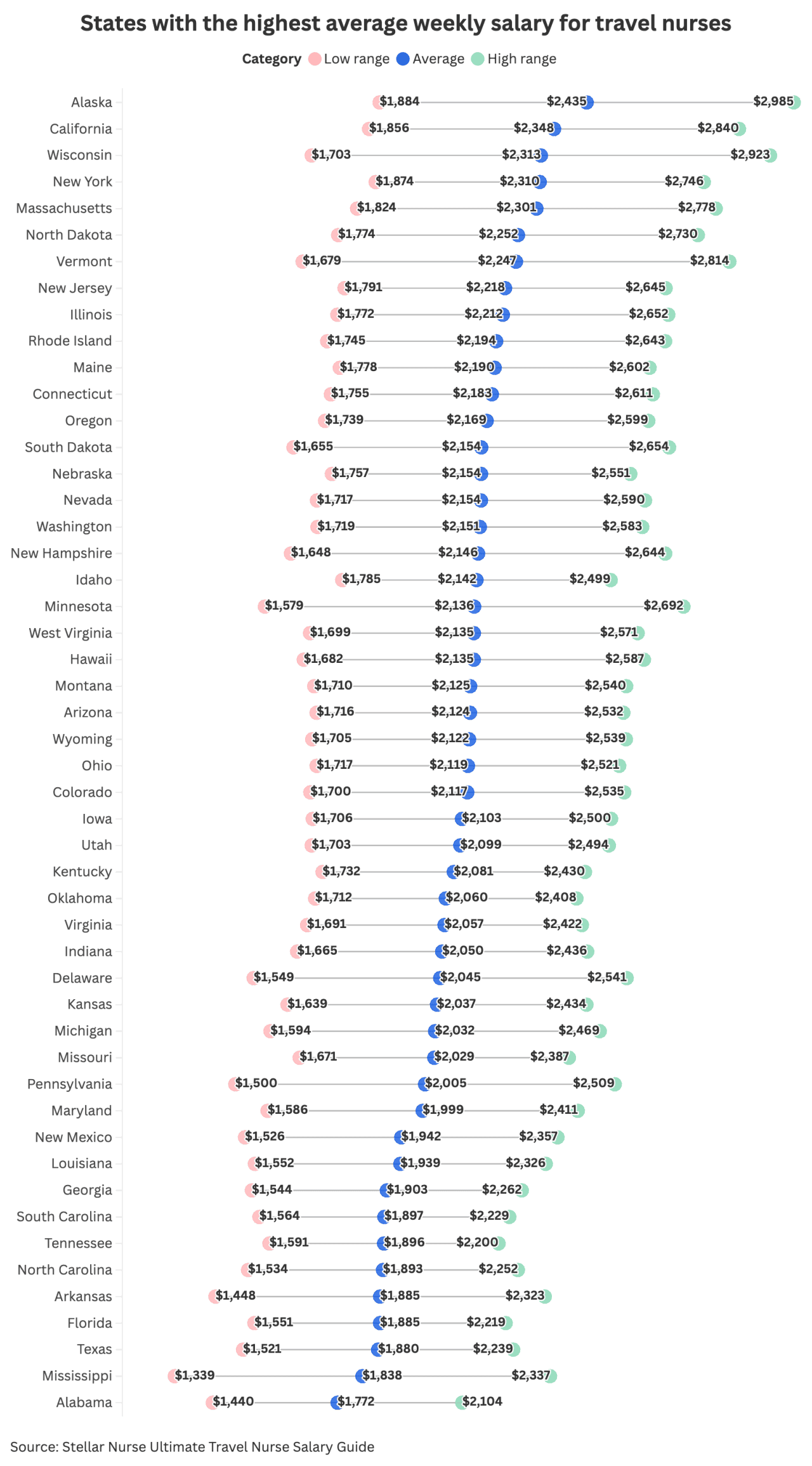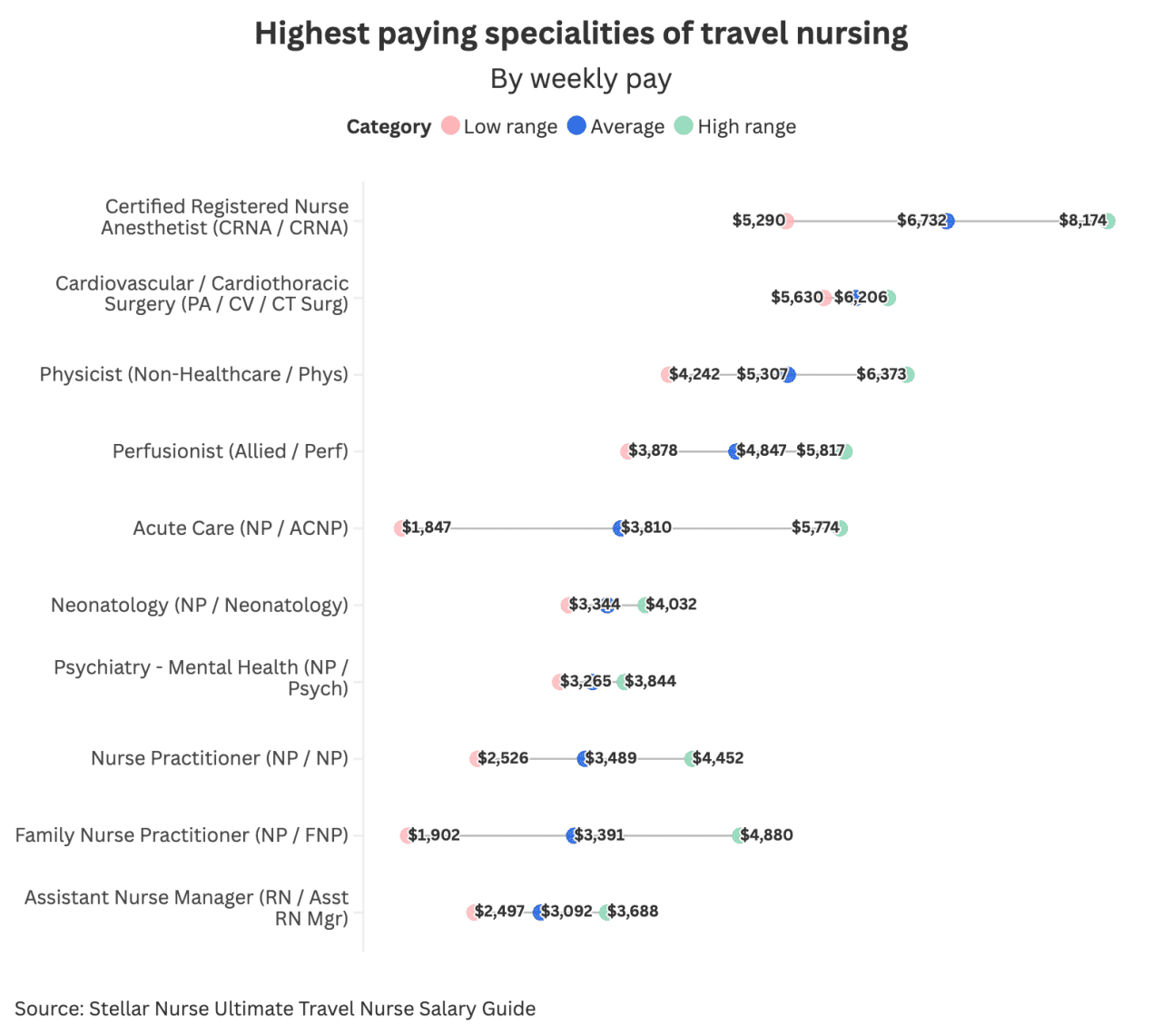
July 17, 2025
Whether you’re just getting started or thinking about your next step, knowing where the money is — and how to make it work for you — helps you plan smarter for the road ahead.
Where travel nurses earn the most and least: Pay trends by state and specialty
Travel nursing gained momentum during the COVID-19 pandemic and has continued to grow. In 2020, Staffing Industry Analysts reported that travel nurse staffing demand jumped 35%.
What used to make up just 3%-4% of hospital nursing staff ballooned to 8%-10% by mid-2021. Hospitals relied heavily on travel nurses to maintain care, transforming what was once a temporary solution into a core part of the system.
The idea isn’t new, but it didn’t gain mainstream traction until more recently, when COVID-19 pushed interest into high gear. In January 2019, travel nurses were working 4% of all hours worked by nurses in hospitals, according to Syntellis Performance Solutions data. By January 2022, that number reached 23%.
National Health Ratings looks at where travel nurses are earning the most — and the least — using data from the Stellar Nurse Ultimate Travel Nurse Salary Guide. This story will break down how pay varies by location, specialty, and demand in today’s fast-changing healthcare world.
The travel nursing boom: From crisis response to career path
Before COVID: a niche solution
Travel nursing officially began in 1978 with the establishment of TravCorps in New Orleans. From the beginning, it was all about filling staffing gaps — whether from regional shortages, seasonal surges, or new hospital programs. Travel nurses made up just a small part of the workforce. The jobs paid well and offered flexibility, but most nurses still viewed them as temporary gigs, rather than full-time careers.
How the pandemic changed everything
In 2020, the COVID-19 pandemic hit, and demand for travel nurses surged. By August 2021, more than 30,000 travel nurse jobs were available, according to health care staffing firm SimpliFi. The pay, flexibility, and urgent need turned short-term contracts into a serious long-term option for many nurses.
Now: High demand, slower pace
The travel nursing market is cooling, but it remains stronger than it was before the pandemic, according to Staffing Industry Analysts. After peaking at $42.7 billion in 2022, a 2025 report from TravelNurses indicates that the U.S. industry is expected to stabilize at around $19.5 billion by 2025, which is almost triple the pre-pandemic level. Looking ahead, WiFiTalents projects the industry to grow steadily at a rate of 5.8% annually through 2028.
Where travel nurses earned the most and least
Travel nurse pay swings hard depending on where you go. According to the Stellar Nurse Ultimate Travel Nurse Salary Guide, Alaska leads the pack with an average weekly wage of $2,435. California isn’t far behind at $2,348, followed by Wisconsin ($2,313), New York ($2,310), and Massachusetts ($2,301). These high-paying states often come with higher living costs, a strong union presence, and high demand for big-city hospitals.
At the lower end? Alabama averages just $1,772 per week, with Mississippi, Texas, Florida, and Arkansas all hovering around $1,880 per week. While the cost of living in these states is lower, it rarely makes up for the smaller paychecks.

Regional trends are shifting, too. In Q1 2025, salaries increased by 0.7% in the West but decreased by 0.88% in the South, suggesting stronger demand and better funding along the coasts. Big cities typically pay more than rural areas.
Still, weekly pay isn’t the whole story. Real value comes from the complete package; think housing stipends, tax-free benefits, and how far your money goes in a given city.
How specialization shapes travel nurse pay
Location matters — but what you specialize in can matter even more. Nurses working in high-stress, high-demand specialties consistently top the pay charts.
At the very top, Certified Registered Nurse Anesthetists (CRNAs) pull in about $6,732 per week, with some hitting $8,000 or more. Cardiovascular and cardiothoracic surgery physician assistants earn $5,918, and even nonclinical roles, such as medical physicists, average $5,307 a week.
Other strong earners include perfusionists ($4,847) and acute care nurse practitioners (ACNPs), who average around $3,810 per week. These jobs usually require advanced certifications and deep experience in critical care or surgical environments.

Experience boosts earnings, too. New travel nurses typically earn between $90,000 and $100,000 per year. In contrast, seasoned ICU nurses can earn $150,000 or more, especially with credentials such as Certified Critical Care Registered Nurse, Trauma Nursing Core Course, or Certified Pediatric Nurse under their belt.
Specialty training isn’t cheap, but the payoff can be huge. For nurses seeking to maximize their income, investing in high-acuity certifications is one of the most strategic moves.
What nurses earn: Beyond the base rate
Travel nurse pay isn’t just about the hourly wage. The full compensation package includes tax-free stipends, travel reimbursements, and long-term benefits that can significantly enhance take-home value.
Stipends and daily support
Housing stipends are one of the most significant benefits. Nurses also receive a daily meal and incidental allowances based on the federal General Services Administration’s per diem rates. Additionally, perks may include travel and relocation costs, ranging from gas and airfare to licensing fees.
Tax perks that add up
Many of these stipends are nontaxable as long as nurses keep a qualifying tax home. That setup can lead to thousands in annual savings, especially compared to permanent staff roles with similar base pay.
Benefits that go the distance
Top agencies offer comprehensive health insurance on day one, along with additional benefits such as 401(k) matching, continuing education funds, and certification support. Some even offer bonuses for completing contracts or staying with the same agency over time.
Add it all up, and travel nursing remains a strong financial option, even when base pay varies by state or specialty.
What it takes to become a travel nurse
Education and licensing basics
To start, you’ll need to become a licensed registered nurse (RN). That means earning either an associate degree in nursing or a Bachelor of Science in Nursing — though many hospitals now prefer or require a BSN — and passing the National Council Licensure Examination for RNs.
To work across state lines more easily, many nurses get a multistate license through the Nurse Licensure Compact (NLC). Currently, 43 states fully participate, allowing nurses in those states to take assignments without needing to reapply for a license each time.
Experience requirements
Most agencies want at least one to two years of hands-on clinical experience. If you’re aiming for specialties like ICU, ER, or OR, expect to need two or more years of post-orientation work. An inpatient experience is usually a must; hospitals tend to pass on candidates with only a clinic or outpatient background for high-acuity roles.
Finding the right agency
Choosing the right staffing agency matters. Look for one that offers precise pay details, substantial benefits, and solid recruiter support. A good recruiter will match you with the right jobs, walk you through contracts, and make sure you understand the full compensation package before you sign on.
The bottom line on travel nursing today
For nurses chasing flexibility and better pay, it’s still one of the most appealing career paths out there. From high-paying coastal gigs to growing demand in the Midwest, nurses can tailor their assignments to align with their income goals, lifestyle, and experience.
There’s room to grow, too. Specializing in high-acuity areas or earning advanced certifications opens the door to top-tier contracts and better rates. When combined with innovative agency partnerships, tax-savvy planning, and long-term career objectives, travel nursing becomes more than a short-term move; it becomes a viable and rewarding career path.
Whether you’re just getting started or thinking about your next step, knowing where the money is — and how to make it work for you — helps you plan smarter for the road ahead.
National Health Ratings produced this story and reviewed and distributed it by Stacker.
RELATED CONTENT: Grass Grievance: Homeowner Jailed In Weird Battle With HOA


